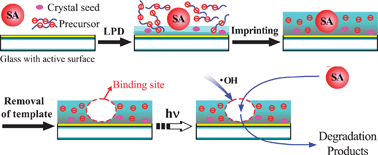Molecular imprinted thin films (MIFs) of TiO2 were prepared with a liquid phase deposition (LPD) method, and characterized by FT-IR spectroscopy, UV-visible solid-state reflection spectroscopy, X-ray diffraction, and scanning electron microscopy. Among different approaches of removing the template in the preparation of MIFs, a calcination treatment was the best to produce more 3D “molecular footprint” cavities of the template on the MIF, which promoted further the photocatalytic activity of the MIF in comparison with the films pre-treated by extraction or photodegradation. Compared with the non-imprinted TiO2 film (NIF), the MIF enhanced the photodegradation of the target pollutants by increasing the adsorption of the target pollutants on the surface of the MIF. From the Langmuir–Hinshelwood model, the value of the apparent reaction rate constant on the MIF was obtained, which was much larger than that on the NIF. The equilibrium adsorption constant on the MIF was more than 7 times that on the NIF. Because of this high affinity, the MIF exhibited special molecular recognition ability, leading to selective adsorption and photodegradation of the target pollutant. Moreover, the MIF was confirmed to have good stability during long-time photocatalysis.

You have access to this article
 Please wait while we load your content...
Something went wrong. Try again?
Please wait while we load your content...
Something went wrong. Try again?


 Please wait while we load your content...
Please wait while we load your content...